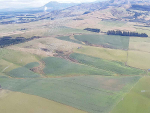During dry spells irrigating farmers come under the spotlight.
Many people ask why irrigation can continue when water restrictions are imposed on townies – especially irrigation on hot, windy days. Critics ask whether irrigation threatens the viability of their domestic water supply and they take issue with the type of irrigators in use, particularly the centre pivot models or ‘large sprinklers’ commonly seen.
Let’s address these concerns one by one.
Irrigating farmers face the same scenario as townsfolk – i.e. limited water during extended dry periods such as this summer. But resource management law gives priority to households – meaning commercial users such as farmers will always face restricted water supply before domestic households do.
District councils regulate for domestic water supply during dry spells. The restrictions are a combination of water scarcity and infrastructure capacity and no system is built to cope with absolute peak demand as the cost would be prohibitive.
The same applies on farms. Irrigating farmers are subject to restrictions imposed by regional councils, which base their decisions on monitoring the health and flows of local rivers and streams. But, note that the source of water for irrigation is not related to the intake and infrastructure that supports a domestic supply.
So in a town, city or village facing water restrictions, it’s quite likely the water supply intake is under pressure and the local council’s distribution system can’t cope; whereas irrigating farmers are put on restriction by regional councils to preserve the water resource they tap into. The two processes are quite separate and handled by different councils for different reasons.
Regarding the ‘timing’ of irrigation: farmers irrigate according to a schedule so they can’t always stop when high evaporation conditions occur. Irrigation schedules take into account the farm’s soil moisture (how dry the land is), weather forecasts (whether rain is on the horizon) and when they have access to water. If they are on a roster from a community irrigation scheme they will need to use the water on the day it’s allocated to them regardless of weather – wind or rain.
Water losses can occur during irrigating on a windy day, but research has shown they are minimal (less than 5%). The main side effect of irrigating on a windy day is a change in the water distribution pattern. In this situation, the irrigation system, the wind’s strength and the weather can create challenges for plant growth.
Well-designed irrigation systems and smart management by farmers and farm staff in charge of irrigation can drastically reduce water losses (in some cases to less than 10%). If we restricted farmers to only operating irrigation at night to further minimise evaporative losses caused by the sun, we’d need to double the amount of irrigators and water supply New Zealand currently uses.
Some people question the move to centre pivot irrigators, perceiving them to waste water. We often hear people speak fondly of the old ‘border dyke’ systems, arguing that these open race canals are more efficient at distributing water.
But it’s a misconception that evaporation from centre pivots is higher than border dyke and open race systems. Border dyke systems are far less efficient and lose more water than the modern spray systems, both through evaporation and leakage. The combination of larger surface areas (open races and flooded borders) for evaporation and through ground drainage (because of the large volume of water being applied) means water losses of 40 - 50% are common. This is why most irrigation schemes in New Zealand are upgrading away from border dyke systems at their own substantial cost to improve water use efficiency and reduce water losses.
Moving to highly efficient modern irrigation systems like centre pivots is a responsible move by the irrigation industry.
Water is always an emotive topic and this summer we’re being reminded that we all need to be careful with this precious resource.
The drought two summers back cost New Zealand at least $1bn. Farmers in many areas could suffer losses in the millions this year.
• Andrew Curtis is the chief executive of Irrigation New Zealand.











